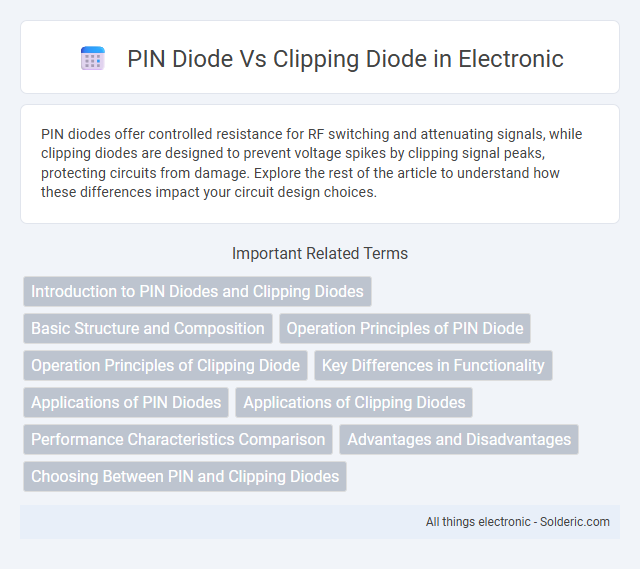PIN diodes offer controlled resistance for RF switching and attenuating signals, while clipping diodes are designed to prevent voltage spikes by clipping signal peaks, protecting circuits from damage. Explore the rest of the article to understand how these differences impact your circuit design choices.
Comparison Table
| Feature | PIN Diode | Clipping Diode |
|---|---|---|
| Function | Used as a variable resistor or switch in RF and microwave circuits | Protects circuits by clipping voltage signals beyond a threshold |
| Structure | Intrinsic layer between P-type and N-type regions | Standard P-N junction diode |
| Application | Attenuators, RF switches, phase shifters | Signal conditioning, voltage limiting, waveform shaping |
| Response Time | Fast switching, suitable for high-frequency applications | Fast clipping action, dependent on diode type |
| Operation Mode | Forward/reverse biased for controlling resistance | Clips voltage once forward voltage threshold is reached |
| Frequency Range | MHz to GHz | Low to medium frequency signals |
| Voltage Handling | Moderate, designed for RF power levels | Limited to breakdown or clipping voltage |
| Key Benefit | Low insertion loss and high linearity in RF circuits | Prevents signal distortion by limiting amplitude |
Introduction to PIN Diodes and Clipping Diodes
PIN diodes feature a wide, undoped intrinsic semiconductor region between p-type and n-type layers, enabling them to act as variable resistors at RF and microwave frequencies, ideal for switching and attenuating signals. Clipping diodes function by limiting signal voltage to a predefined threshold, protecting circuits from voltage spikes by "clipping" waveform peaks. Understanding these diode types helps you optimize circuit protection and signal control in high-frequency electronic applications.
Basic Structure and Composition
A PIN diode consists of an intrinsic layer sandwiched between p-type and n-type semiconductor regions, creating a wide depletion region that enables efficient high-frequency signal control. Clipping diodes are typically standard p-n junction diodes designed to limit voltage levels by clipping signal peaks and have a simpler two-layer structure without an intrinsic layer. Your choice between the two depends on whether you need broadband switching and attenuation (PIN diode) or voltage clipping for signal protection (clipping diode).
Operation Principles of PIN Diode
PIN diodes feature a wide intrinsic semiconductor layer between p-type and n-type regions, allowing them to act as variable resistors controlled by the applied current, making them ideal for RF switching and attenuation. In contrast, clipping diodes operate by rapidly switching between on and off states to limit voltage levels, thereby protecting circuits from voltage spikes. Your choice depends on whether precise signal modulation or voltage clipping is required in your application.
Operation Principles of Clipping Diode
Clipping diodes operate by limiting the voltage to a specific level, protecting circuits by preventing signal peaks from exceeding a predefined threshold. They function based on the diode's ability to conduct current only beyond a certain forward voltage, effectively "clipping" the signal waveform and maintaining voltage within safe limits. Your circuit benefits from clipping diodes in safeguarding sensitive components and ensuring signal integrity by controlling excessive voltage spikes.
Key Differences in Functionality
PIN diodes function primarily as variable resistors in RF circuits, controlling signal attenuation and switching by exploiting their intrinsic layer's charge storage. Clipping diodes protect circuits by limiting voltage levels, clipping signal peaks to prevent distortion or damage in audio and RF applications. The key difference lies in the PIN diode's role in signal modulation and switching, whereas clipping diodes serve as voltage limiters to maintain signal integrity.
Applications of PIN Diodes
PIN diodes are widely used in RF switches, attenuators, and photodetectors due to their fast switching capabilities and low distortion at high frequencies. Their intrinsic layer allows for efficient modulation of RF signals, making them ideal in communication systems and radar technology. Unlike clipping diodes, PIN diodes work effectively as variable resistors in these applications, enhancing signal control and strength.
Applications of Clipping Diodes
Clipping diodes are primarily used in signal processing to limit voltage levels and protect circuits from voltage spikes by clipping waveforms at predetermined thresholds. Common applications include audio signal shaping, waveform generators, and voltage regulation circuits, where they ensure signal integrity and prevent distortion. Your electronic designs benefit from clipping diodes by maintaining signal stability and avoiding damage caused by excessive voltages.
Performance Characteristics Comparison
PIN diodes exhibit excellent RF switching capabilities with low insertion loss and high isolation, making them ideal for high-frequency applications, whereas clipping diodes excel in protecting circuits by limiting voltage spikes through fast response and low forward voltage. The intrinsic layer within PIN diodes enhances their linearity and power handling, contrasting with the nonlinear behavior of clipping diodes, which prioritize voltage clamping over signal fidelity. Performance-wise, PIN diodes offer superior switching speed and power dissipation efficiency, while clipping diodes emphasize robust transient suppression and circuit protection under overload conditions.
Advantages and Disadvantages
PIN diodes offer advantages such as high-frequency operation and low distortion, making them ideal for RF switching and attenuator applications, but they tend to have slower response times and higher power consumption compared to clipping diodes. Clipping diodes excel in protecting circuits by limiting voltage spikes through fast response and low cost, though they may introduce distortion and are less suitable for high-frequency switching. Your choice between PIN and clipping diodes should consider the specific needs for speed, frequency range, and signal integrity in your application.
Choosing Between PIN and Clipping Diodes
Choosing between PIN and clipping diodes depends on your application requirements for signal integrity and protection. PIN diodes excel in RF switching and attenuation due to their intrinsic layer, providing low distortion and high-frequency performance. Clipping diodes are ideal for limiting voltage peaks and protecting circuits from transient signals by clipping waveforms at specific voltage levels.
PIN diode vs Clipping diode Infographic

 solderic.com
solderic.com